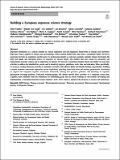Building a European exposure science strategy

View/
Date
2019-12-02Author
Fantke, Peter
von Goetz, Natalie
Schlüter, Urs
Bessems, Jos
Connolly, Alison
Dudzina, Tatsiana
Ahrens, Andreas
Bridges, Jim
Coggins, Marie A.
Conrad, André
Hänninen, Otto
Heinemeyer, Gerhard
Kephalopoulos, Stylianos
McLachlan, Michael
Meijster, Tim
Poulsen, Veronique
Rother, Dag
Vermeire, Theo
Viegas, Susana
Vlaanderen, Jelle
Zare Jeddi, Maryam
Bruinen de Bruin, Yuri
Metadata
Show full item recordUsage
This item's downloads: 82 (view details)
Cited 6 times in Scopus (view citations)
Recommended Citation
Fantke, Peter, von Goetz, Natalie, Schlüter, Urs, Bessems, Jos, Connolly, Alison, Dudzina, Tatsiana, Ahrens, Andreas Bridges, Jim, Coggins, Marie A., Conrad, André, Hänninen, Otto, Heinemeyer, Gerhard, Kephalopoulos, Stylianos, McLachlan, Michael, Meijster, Tim, Poulsen, Veronique, Rother, Dag, Vermeire, Theo, Viegas, Susana, Vlaanderen, Jelle, Jeddi, Maryam Zare, Bruinen de Bruin, Yuri. (2020). Building a European exposure science strategy. Journal of Exposure Science & Environmental Epidemiology, 30(6), 917-924. doi:10.1038/s41370-019-0193-7
Published Version
Abstract
Exposure information is a critical element in various regulatory and non-regulatory frameworks in Europe and elsewhere. Exposure science supports to ensure safe environments, reduce human health risks, and foster a sustainable future. However, increasing diversity in regulations and the lack of a professional identity as exposure scientists currently hamper developing the field and uptake into European policy. In response, we discuss trends, and identify three key needs for advancing and harmonizing exposure science and its application in Europe. We provide overarching building blocks and define six long-term activities to address the identified key needs, and to iteratively improve guidelines, tools, data, and education. More specifically, we propose creating European networks to maximize synergies with adjacent fields and identify funding opportunities, building common exposure assessment approaches across regulations, providing tiered education and training programmes, developing an aligned and integrated exposure assessment framework, offering best practices guidance, and launching an exposure information exchange platform. Dedicated working groups will further specify these activities in a consistent action plan. Together, these elements form the foundation for establishing goals and an action roadmap for successfully developing and implementing a European Exposure Science Strategy 2020 2030, which is aligned with advances in science and technology.
Collections
Except where otherwise noted, this item's license is described as Attribution-NonCommercial-NoDerivs 3.0 Ireland
Related items
Showing items related by title, author, creator and subject.
-
Framework for developing an exposure science curriculum as part of the European Exposure Science Strategy 2020–2030
Connolly, Alison; Scheepers, Paul T. J.; Coggins, Marie; Vermeire, Theo; van Tongeren, Martie; Heinemeyer, Gerhard; Bridges, James W.; Bredendiek-Kämper, Susanne; Bruinen de Bruin, Yuri; Clayson, Anne; Gerding, Johannes; McCourt, Josephine; Urbanus, Jan; Viegas, Susana; von Goetz, Natalie; Zare-Jeddi, Maryam; Fantke, Peter (Elsevier, 2022-08-20)Background Evaluating and managing exposures to chemical, physical and biological stressors, which frequently interplay with psychological stressors as well as social and behavioural aspects, is crucial for protecting ... -
Modelling of Inhalation Exposures to Pharmaceutical Agents
Mc Donnell, Patricia (2011-09-09)Assessment of worker's exposure is becoming increasingly critical in the pharmaceutical industry as drugs of higher potency are being manufactured. Also the batch nature of operations often makes it difficult to obtain ... -
Bumblebee learning and memory is impaired by chronic exposure to a neonicotinoid pesticide.
Stanley, Dara A.; Smith, Karen E.; Raine, Nigel E. (Nature Publishing Group, 2015-11-16)Bumblebees are exposed to pesticides applied for crop protection while foraging on treated plants, with increasing evidence suggesting that this sublethal exposure has implications for pollinator declines. The challenges ...

